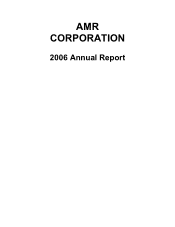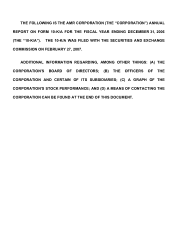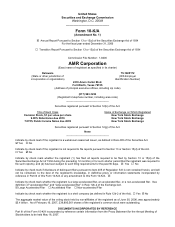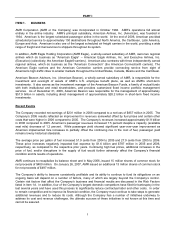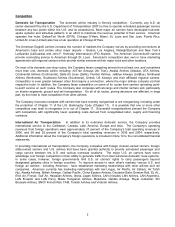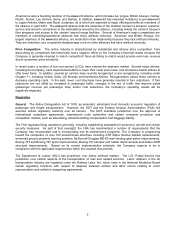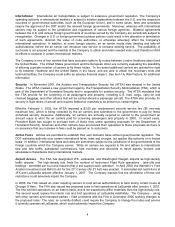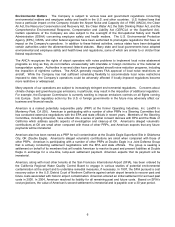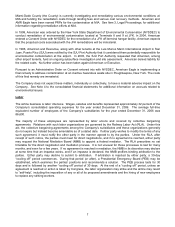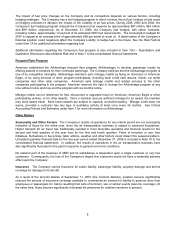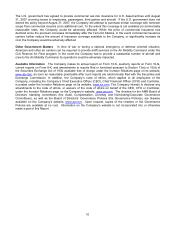American Airlines 2006 Annual Report Download - page 6
Download and view the complete annual report
Please find page 6 of the 2006 American Airlines annual report below. You can navigate through the pages in the report by either clicking on the pages listed below, or by using the keyword search tool below to find specific information within the annual report.
2
Competition
Domestic Air Transportation The domestic airline industry is fiercely competitive. Currently, any U.S. air
carrier deemed fit by the U.S. Department of Transportation (DOT) is free to operate scheduled passenger service
between any two points within the U.S. and its possessions. Most major air carriers have developed hub-and-
spoke systems and schedule patterns in an effort to maximize the revenue potential of their service. American
operates five hubs: Dallas/Fort Worth (DFW), Chicago O'Hare, Miami, St. Louis and San Juan, Puerto Rico.
United Air Lines (United) also has a hub operation at Chicago O'Hare.
The American Eagle® carriers increase the number of markets the Company serves by providing connections at
American’s hubs and certain other major airports -- Boston, Los Angeles, Raleigh/Durham and New York’s
LaGuardia (LaGuardia) and John F. Kennedy International (JFK) Airports. The American Connection® carriers
provide connecting service to American through St. Louis. American's competitors also own or have marketing
agreements with regional carriers which provide similar services at their major hubs and other locations.
On most of its domestic non-stop routes, the Company faces competing service from at least one, and sometimes
more than one, domestic airline including: AirTran Airways (Air Tran), Alaska Airlines (Alaska), ATA Airlines,
Continental Airlines (Continental), Delta Air Lines (Delta), Frontier Airlines, JetBlue Airways (JetBlue), Northwest
Airlines (Northwest), Southwest Airlines (Southwest), United, US Airways and their affiliated regional carriers.
Competition is even greater between cities that require a connection, where the major airlines compete via their
respective hubs. In addition, the Company faces competition on some of its routes from carriers operating point-
to-point service on such routes. The Company also competes with all-cargo and charter carriers and, particularly
on shorter segments, ground and rail transportation. On all of its routes, pricing decisions are affected, in large
part, by the need to meet competition from other airlines.
The Company must also compete with carriers that have recently reorganized or are reorganizing, including under
the protection of Chapter 11 of the U.S. Bankruptcy Code (Chapter 11). It is possible that one or more other
competitors may seek to reorganize in or out of Chapter 11. Successful reorganizations present the Company
with competitors with significantly lower operating costs derived from renegotiated labor, supply and financing
contracts.
International Air Transportation In addition to its extensive domestic service, the Company provides
international service to the Caribbean, Canada, Latin America, Europe and Asia. The Company's operating
revenues from foreign operations were approximately 37 percent of the Company’s total operating revenues in
2006, and 36 and 35 percent of the Company’s total operating revenues in 2005 and 2004, respectively.
Additional information about the Company's foreign operations is included in Note 14 to the consolidated financial
statements.
In providing international air transportation, the Company competes with foreign investor-owned carriers, foreign
state-owned carriers and U.S. airlines that have been granted authority to provide scheduled passenger and
cargo service between the U.S. and various overseas locations. The major U.S. air carriers have some
advantage over foreign competitors in their ability to generate traffic from their extensive domestic route systems.
In some cases, however, foreign governments limit U.S. air carriers' rights to carry passengers beyond
designated gateway cities in foreign countries. To improve access to each other's markets, various U.S. and
foreign air carriers - including American - have established marketing relationships with other airlines and rail
companies. American currently has marketing relationships with Aer Lingus, Air Pacific, Air Sahara, Air Tahiti
Nui, Alaska Airlines, British Airways, Cathay Pacific, China Eastern Airlines, Deutsche Bahn German Rail, EL AL,
EVA Air, Finnair, Gulf Air, Hawaiian Airlines, Iberia, Japan Airlines, LAN (includes LAN Airlines, LAN Argentina,
LAN Ecuador and LAN Peru), Malév Hungarian Airlines, Mexicana, Qantas Airways, Royal Jordanian, SN
Brussels Airlines, SNCF French Rail, TAM, Turkish Airlines and Vietnam Airlines.

